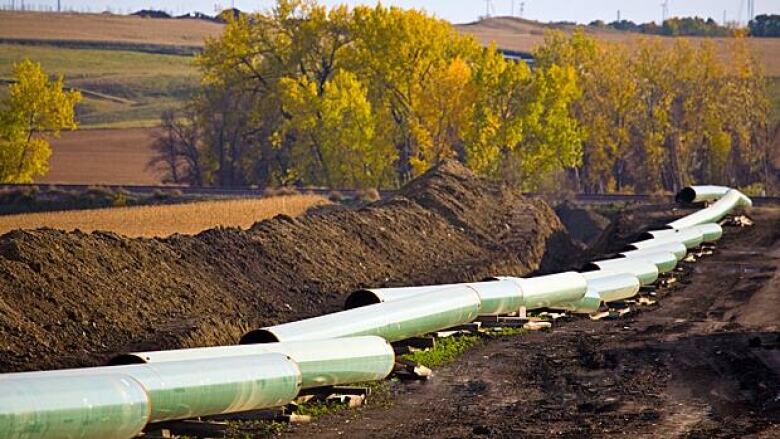TransCanada pushes ahead on Keystone segment

TransCanada Corp. could begin construction of a vital segment of its Keystone XL oil pipeline before U.S. regulators have signed off on the project as a whole.
Executives at the company told an investor conference in Toronto Wednesday that the section of pipeline between the energy hub of Cushing, Okla. and the U.S. Gulf Coast could be prioritized, to alleviate a supply glut.
As it stands, millions of barrels of crude oil come into Cushing every day from all across North America, but there isn't enough infrastructure in place at the moment to efficiently move it to refineries and export ports on the coast. There's a massive bottleneck, which has depressed prices for North American oil versus its European counterpart, Brent Crude.
Indeed, TransCanada rival Enbridge Inc.announced Wednesday it would pay $1.15 billion US to acquire a half-stake in the Seaway pipeline, and reverse its flow to bring crude from Cushing to the Gulf. The Seaway could potentially move 350,000 barrels a day.
Investors responded favourably to that move,pushing the price of a barrel of the North American benchmark, West Texas Intermediate, up $3.22 to$102.59in anticipation of that pipeline helping to alleviate the supply-demand imbalance.
Alex Pourbaix, TransCanada's president of energy and oil pipelines, said thecompany is focusing on getting as much crude as possibletothe Gulf Coast. "The focus remains on getting to the Gulf Coast at Port Arthur and Houston," he said.
"The first thing that we need to do is spend a little bit of time with our shippers and see sort of where they stand," he said."Certainly the message we're hearing is that they would very much like to see that Cushing-to-Gulf Coast phase come in as soon as possible. So we'll take a very hard look at the commercial underpinnings for that."
CEO Russ Girling echoed those comments about holding talks with shippersbut reiterated that the company remains focused on the broader project.
"Our shippers are going to ask us the question of whether or not we would consider moving faster on what we call Phase 3 of the project,"Girling said."We may or may not do that going forward. Our focus is on building this entire project."
Girling said 100 per centof the pipe for the pipeline has already been ordered, and the equipment needed to move the oil through the pipeline has also been ordered.
He alsohinted Wednesday that the company is looking at other options to pump oilsands oil west toward Canada's Pacific coast or possibly find other eastern hubs. But the U.S. Gulf Coast remains the focus.
"We think the logical market for Canadian crude is the U.S. Gulf Coast," Girling said."Canada produces more than it consumes, and the U.S. consumes more than it produces, so it makes sense to marry those."
Mounting delays
TransCanada has been trying to build a $13 billion, 2,700-kilometre pipeline from Alberta's oilsands to the U.S. Gulf Coast for years. Known as the Keystone XL project, the company has faced increased pressure from environmentalists in the U.S. this year who don't want the project to get any larger than it already is.
Two sections of the plan already exist the first stage that ends in Wood River, Ill., was completed in June 2010. And a second phase, from Steele City, Neb., to Cushing was finished in the fall. Service to Cushing began earlier this year. If it's completed, the entire Keystone XLpipeline will move 1.4 million barrels of oil per day. That's about one-third of Canada's daily energy exports to the U.S.
Other projects are continuing in a race to supply the Gulf Coast first. Enterprise Products Partners LP has linked up with TransCanada rival Enbridge to build the 800-kilometre Wrangler pipeline, which will also connect Cushing to this distribution hub of Houston.
Last week, the U.S. Department of State delayed ruling on Keystone XL,saying they need more time to consider a proposal to reroute the plan away from the Sandhills region of Nebraska and away from the Ogallala aquifer that supplies drinking water to six U.S. states.
Following the State Department's announcement that it will delay its decision until at least 2013, TransCanada said it would work with the Nebraska government on a different path for the project.
On Wednesday, Nebraska politiciansvoted in favour of aplan to have the state's Department of Environmental Quality conduct an independent review of possible routes the pipeline could take through the state.
"The unanimous vote today of the Nebraska legislature certainly lays the groundwork for that co-operative process to commence," Girling said.
It's believed a new environmental assessment could take as much as 12 to 18 months, but TransCanada said Wednesday that it could win approval for the whole project in as little as six to nine months.
Under the best-case scenario, TransCanada could start digging the Cushing section in the new year, provided environmental assessments already completed for that part of the line don't need to be updated.
"I think at the worst we would require the permission of the State Department to proceed on that rather than as part of the entire process," said Pourbaix.
He said building the Cushing leg first is "definitely doable," but TransCanada needs to run it by the State Department.
"Out of an overabundance of caution on our own side, we would want to make sure that everybody at the State Department would be happy with that kind of a proposal."
Quoting an unnamed official, Reuters reported Wednesday that the company has yet to contact the State Department about expediting the Oklahoma-to-Texas portion of the project.
With files from CBC's Mike Hornbrook and The Canadian Press












_(720p).jpg)


 OFFICIAL HD MUSIC VIDEO.jpg)
.jpg)



























































































